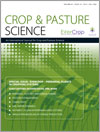
Crop and Pasture Science
Volume 65 Number 10 2014
EverCrop – Perennial Plants in Cropping Systems
CP14111Developing the role of perennial forages for crop–livestock farms: a strategic multi-disciplinary approach
CP14049A review of pasture establishment by undersowing with special reference to the mixed farming zone of south-eastern Australia
Pastures are typically sown either directly or in combination with a cover-crop, so that the establishment cost is offset by income from the sale of grain. However, no data published quantified the risks associated with undersowing on a seasonal and regional basis to determine the probability of success, and there are insufficient data to model the complex physiological interactions between crop and pasture. This review identifies substantial research gaps to be addressed to improve pasture-establishment decisions.
CP13448Farmer experience with perennial pastures in the mixed farming areas of southern New South Wales: on-farm participatory research investigating pasture establishment with cover-cropping
CP13447Time of sowing and the presence of a cover-crop determine the productivity and persistence of perennial pastures in mixed farming systems
Success in establishing perennial pastures depends on choice of species, time of sowing and method of establishment. Lucerne was the most productive pasture, followed by chicory and phalaris, with cocksfoot being the poorest performer. The non-legume perennial species, such as chicory and phalaris, should be sown in autumn with companion annual legumes whereas lucerne can be established in autumn or spring. Establishing perennial pastures with a cover crop is not recommended under dry conditions.
CP13442Pasture cropping with C4 grasses in a barley–lupin rotation can increase production
Barley and lupins were cropped into established C4 pasture grasses in Western Australia. Barley and lupin yields were reduced by up to 26% and 29% respectively with high inputs. Under low-input conditions, pasture cropping did not significantly reduce crop yield, and frequently increased crop yields. Grain yield losses were lower in the low-input system and competition between the crop and pasture was reduced in a nitrogen-limited environment. The level of competition between the species was dependant on season.
CP14046Soil-water dynamics in a pasture-cropping system
In Western Australia, sandy soils are often associated with low productivity, and their poor water-holding capacity can lead to increased groundwater recharge and associated dryland salinity. Farmers are experimenting with perennial grasses that become dormant during the winter, allowing crop growth, but become active during the summer, restricting groundwater recharge and potentially increasing total productivity. In this research we show that growing a crop in a perennial pasture maintains the environmental benefits of the pasture, and increases the total water use efficiency of the farming system.
CP13436Selection of crop cultivars suited to the location combined with astute management can reduce crop yield penalties in pasture cropping systems
For pasture-cropping systems (where cereal crops and perennial pastures are grown together) to be profitable, they must be managed carefully to ensure that competition and crop yield penalties are minimised. Growing-season temperature, seasonal rain, soil-water content during crop flowering, and interactions between these components were identified as important drivers of yield penalties under pasture cropping. This study found that selection of location and crop cultivar will affect the yield penalty from pasture cropping compared with growing monoculture crops; agronomic strategies to minimise interspecies competition and improve intercrop productivity are suggested.
CP13444Summer-growing perennial grasses are a potential new feed source in the low rainfall environment of southern Australia
Mixed crop–livestock farms in dry regions of southern Australia often contend with feed shortages in summer–autumn. Based on experimental trials and simulation modelling, this research found that growing warm-season perennial grasses on marginal farmland could address the feed gap by providing forage outside the main winter growing season. As such, the perennial pastures can contribute to improved farm profitability and environmental sustainability.
CP14109Nitrogen cycling in summer active perennial grass systems in South Australia: non-symbiotic nitrogen fixation
Non-symbiotic nitrogen (N2) fixation by diazotrophic bacteria is a potential source for biological N inputs in non-leguminous crops and pastures. This study presents evidence for the presence of a diverse diazotrophic (nifH) community and provides quantitative estimates of the amount of N2 fixed within the roots and rhizosphere soil of summer-active perennial grasses in a Mediterranean region of South Australia. The quantity of N2 fixation, estimated using a 15N isotope method, was generally higher with the roots than in the rhizosphere soil.
CP13413Opportunities for plant improvement to increase the value of forage shrubs on low-rainfall mixed farms
There is evidence that forage shrubs are beneficial to mixed farming systems, but adoption remains low because of productivity and management issues. Results of whole-farm bio-economic modelling show that improvement to feed quality of shrub-based forage blocks increases profitability. This suggests that current work to develop improved shrub types or mixtures of species has the potential to lead to greater incorporation of forage shrubs in mixed cropping and livestock systems.
CP13452Simulation of water-limited growth of the forage shrub saltbush (Atriplex nummularia Lindl.) in a low-rainfall environment of southern Australia
Forage shrubs are an important part of the feed-base of mixed crop–livestock farms in dry regions. Based on field data collected across different soil types, a simulation model was developed to predict the growth and development of saltbush, as well as regrowth after grazing. The model allows simulation of forage systems containing shrubs across soils and climates.
CP14040Perennial pastures in cropping systems of southern Australia: an overview of present and future research
This overview discusses the use of perennial plants in cropping landscapes in terms of the concepts of ‘rotation, separation and integration’ and highlights the contribution of papers in this special issue of Crop and Pasture Science across a range of biophysical and socioeconomic factors.



